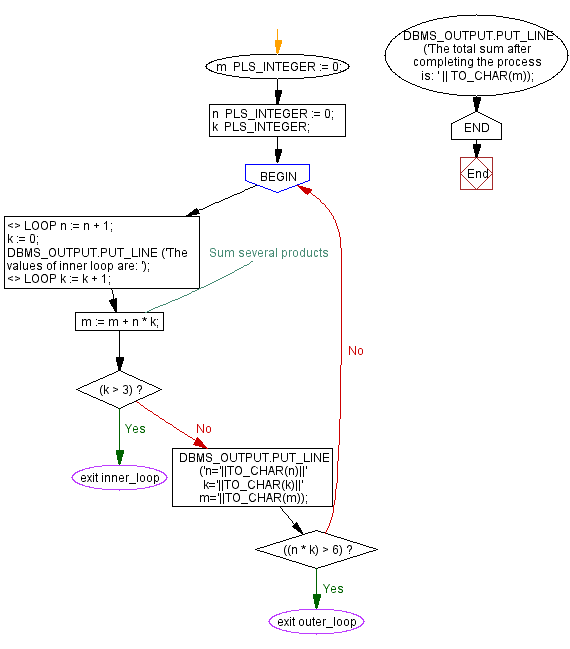PL/SQL Control Statement Exercises: Show the uses of nested loop
PL/SQL Control Statement: Exercise-18 with Solution
Write a program in PL/SQL to show the uses of nested loop.
Sample Solution:
PL/SQL Code:
DECLARE
m PLS_INTEGER := 0;
n PLS_INTEGER := 0;
k PLS_INTEGER;
BEGIN
<>
LOOP
n := n + 1;
k := 0;
DBMS_OUTPUT.PUT_LINE ('The values of inner loop are: ');
<>
LOOP
k := k + 1;
m := m + n * k; -- Sum several products
EXIT inner_loop WHEN (k > 3);
DBMS_OUTPUT.PUT_LINE ('n='||TO_CHAR(n)||' k='||TO_CHAR(k)||' m='||TO_CHAR(m));
EXIT outer_loop WHEN ((n * k) > 6);
END LOOP inner_loop;
END LOOP outer_loop;
DBMS_OUTPUT.PUT_LINE
('The total sum after completing the process is: ' || TO_CHAR(m));
END;
/
Flowchart:

Sample Output:
SQL> / The values of inner loop are: n=1 k=1 m=1 n=1 k=2 m=3 n=1 k=3 m=6 The values of inner loop are: n=2 k=1 m=12 n=2 k=2 m=16 n=2 k=3 m=22 The values of inner loop are: n=3 k=1 m=33 n=3 k=2 m=39 n=3 k=3 m=48 The total sum after completing the process is: 48 PL/SQL procedure successfully completed.
Go to:
PREV : Write a program in PL/SQL to print the value of a variable inside and outside a loop using LOOP WHEN EXIT statement.
NEXT : Write a program in PL/SQL to update the salary of a specifc employee by 8% if the salary exceeds the mid range of the salary against this job and update up to mid range if the salary is less than the mid range of the salary, and display a suitable message.
Improve this sample solution and post your code through Disqus
What is the difficulty level of this exercise?
